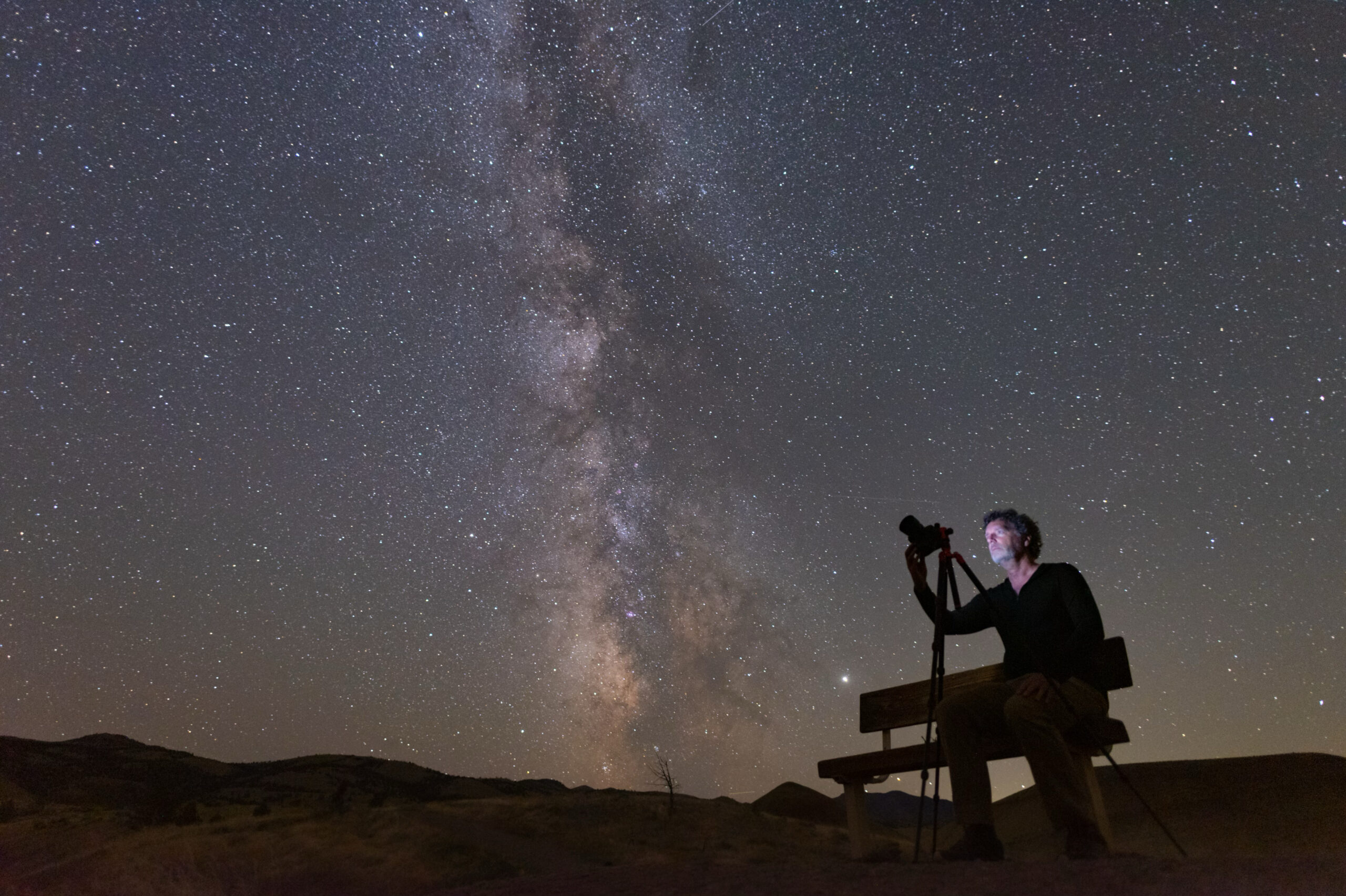Before you purchase your dream astrophotography rig, consider what you can do with a basic setup.
Many would-be astrophotographers stay on the sidelines because they imagine good results can only be achieved with expensive, specialized equipment.
While it’s true that better cameras and lenses generally yield better results, that doesn’t mean you can’t capture the night sky with gear you may have already. Let’s say your main camera is a recent-vintage DSLR (or other interchangeable-lens camera) and the “kit” lens it came with. Could such a basic setup be a practical starting point? There’s no harm in at least trying – and you’ll probably be delighted by what you’re able to capture.
Soaking up Starlight
Kit lenses often feature lightweight plastic construction and offer a zoom range of around 18-55 mm. Night-sky photography is all about gathering as much light as possible, but these budget-friendly lenses usually have small-diameter optics, which limits their performance. And additional features like autofocus and image stabilization don’t help when you’re trying to photograph the night sky. Thankfully, with a few carefully chosen settings, you can still be in the game.
There are three main controls you’ll need to adjust: ISO, lens aperture, and shutter speed. ISO affects the “gain” or sensitivity of your camera’s sensor. Bumping up the ISO won’t increase the actual amount of light captured, but it will produce brighter-looking images. Compared with older models, newer cameras will generally let you use higher ISO values before digital noise starts to spoil the image. You’ll need to experiment with this setting to see what works best for your particular camera body, but I’ve found ISO 1600 is a good starting point.
Next, you’ll want to set the lens to its widest aperture available to allow as much light to reach the camera’s sensor as possible. The ratio between a lens’s focal length and its diameter is called the f-stop or f-ratio. The lower the f-stop number, the bigger the aperture opening and the brighter the image will be. Kit lenses typically have variable f-stops that range from around f/3.5 to f/5.6, with the largest aperture (lowest f-stop value) being at the wide-angle end of the zoom range, and the smallest opening (highest f-stop number) at the fully zoomed end. In other words, to capture the maximum amount of light, you’ll want to zoom out so you can use the absolute widest aperture. One caveat here is that most lenses don’t yield their sharpest images wide open. So, stopping-down slightly by choosing f/4 instead of f/3.5, for example, will often improve image quality, especially at the edges of the frame.
Finally, you’ll want to adjust the shutter speed on your camera. Choose Manual mode (M) to dial in an exposure time of up to 30 seconds. As a starting point try an exposure of 10 seconds. Such a long exposure will require mounting your camera on a tripod to prevent vibration. You’ll also need a way to trip the shutter without jiggling your camera. You can accomplish this by using either the camera’s self-timer (check the owner’s manual) or a shutter release cable. Either way, the idea is to make sure that once the exposure starts, there’s no chance that camera motion will blur the image.

Since the auto-focus systems on most cameras can’t cope with dim starlight, you’ll probably need to switch your lens to manual focus mode and use “live view” (if your camera has that feature) to zoom in and focus on a bright star, planet, or the Moon. Even a very distant streetlight will do. Unfortunately, this is one area in which kit lenses fall down – their plastic construction can make manual focus extremely frustrating. Be patient and do your best. Even a small focus error will lower the overall contrast of your images and obscure faint stars.
Lastly, it’s a good idea to set your camera to record RAW images instead of JPEGs. This will allow you greater flexibility later when it’s time to make adjustments.
Try and Try Again
When everything is set, aim at your target and take a series of test exposures that vary from a few seconds up to 30 seconds long. Try different ISO settings, including the highest one your camera offers. You might be surprised how well it works. Next, try zooming your lens to a longer focal length (you’ll need to refocus) and take another series of test shots. Finally, if you have a shutter release cable or wireless trigger, set your camera to Bulb (B) mode and lock the shutter open for exposures of one minute or even longer. No matter what kind of equipment you have, experimentation is always key to producing the best photos.
Once you’re done shooting and have returned indoors, download the images onto your computer to evaluate what you’ve shot. You should certainly see some stars, but you might be a little underwhelmed by your initial results. This is normal since all astronomical images need some amount of postprocessing to reveal everything you’ve recorded.
If you view your images at 100%, you’ll also notice that as your exposure times increase the stars go from tiny points to little lines. These “star trails” are caused by Earth’s rotation, which always puts you in a race against time when taking astrophotos with a camera mounted on a stationary tripod. While you can’t stop the world from turning, you can counteract its effect by attaching your camera to a motorized equatorial telescope mount or to one of the many inexpensive sky-trackers available. Without one of these options, you will be limited to exposures only a few seconds long if you want pinpoint stars with a kit lens.

Of course, you can embrace star trails rather than trying to fight them. It’s fascinating to see the results you can get by aiming your camera at Polaris, the North Star. Exposures of several hours show wonderful concentric star trails and maybe even the occasional bright meteor.
Your test shots will reveal the challenges and limitations of your equipment. Generally, even inexpensive DSLR cameras are very capable – it’s the kit lens that usually proves to be the weakest link in the imaging chain. That’s the main reason a better lens is often among the first equipment upgrades most astrophotographers make.
Getting Better
If wide-field or landscape astrophotography with a fixed tripod is something you want to explore further, there are many lens options available. Generally, you’ll want to look for lenses with lower f-stops and shorter focal lengths. The lower f-stop collects more light during a given exposure. For example, an f/2.8 lens gathers twice as much light as an f/4. And a wide-angle lets you shoot longer exposures before the stars start to trail noticeably. A lens that combines both of these features is ideal.
If you can mount your camera on a sky-tracking platform, then you may want to look at longer focal-length lenses that will offer more detailed views of individual deep-sky objects. Again, faster (lower f-stop) lenses are better, but this is less of an issue with a tracking mount since you can increase your exposure times dramatically without star trails appearing.

Although a new lens and a tracking platform are both worthwhile purchases, don’t underestimate the value of stretching the equipment you already have to its limits. The lessons you learn by doing so will serve you well in future should you become more ambitious with your astrophotography. And you might find that for your tastes, basic is best.
TONY PUERZER is a full-time professional photographer and part-time amateur astronomer living on Vancouver Island, British Columbia, Canada.

